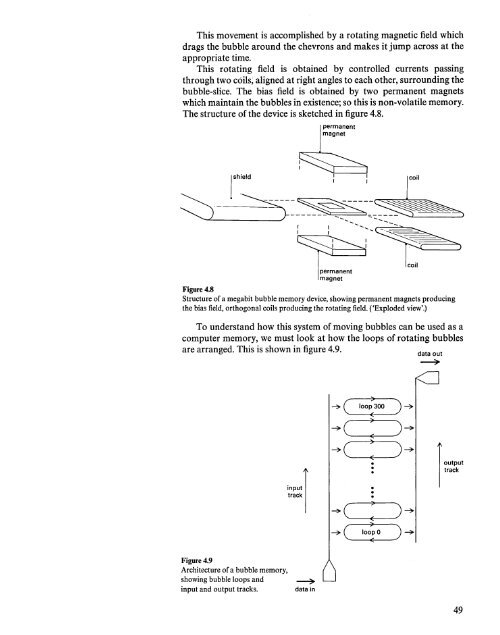Microcomputer Circuits and Processes
Microcomputer Circuits and Processes
Microcomputer Circuits and Processes
You also want an ePaper? Increase the reach of your titles
YUMPU automatically turns print PDFs into web optimized ePapers that Google loves.
This movement is accomplished by a rotating magnetic field which<br />
drags the bubble around the chevrons <strong>and</strong> makes it jump across at the<br />
appropriate time.<br />
This rotating field is obtained by controlled currents passing<br />
through two coils~aligned at right angles to each other, surrounding the<br />
bubble-slice. The bias field is obtained by two permanent magnets<br />
which maintain the bubbles in existence; so this is non-volatile memory.<br />
The structure of the device is sketched in figure 4.8.<br />
permanent<br />
magnet<br />
permanent<br />
magnet<br />
Figure 4.8<br />
Structure of a megabit bubble memory device, showing permanent magnets producing<br />
the bias field, orthogonal coils producing the rotating field. ('Exploded view'.)<br />
To underst<strong>and</strong> how this system of moving bubbles can be used as a<br />
computer memory, we must look at how the loops of rotating bubbles<br />
are arranged. This is shown in figure 4.9.<br />
data out<br />
~<br />
~( IOO~300 )~<br />
~(<br />
: )~<br />
~(<br />
: )~ ! oulpul<br />
track<br />
;npUI!<br />
track<br />
~( :<br />
)~<br />
~( IO~O )~<br />
Figure 4.9<br />
Architecture of a bubble memory,<br />
showing bubble loops <strong>and</strong> ~<br />
input <strong>and</strong> output tracks.<br />
data in<br />
49











